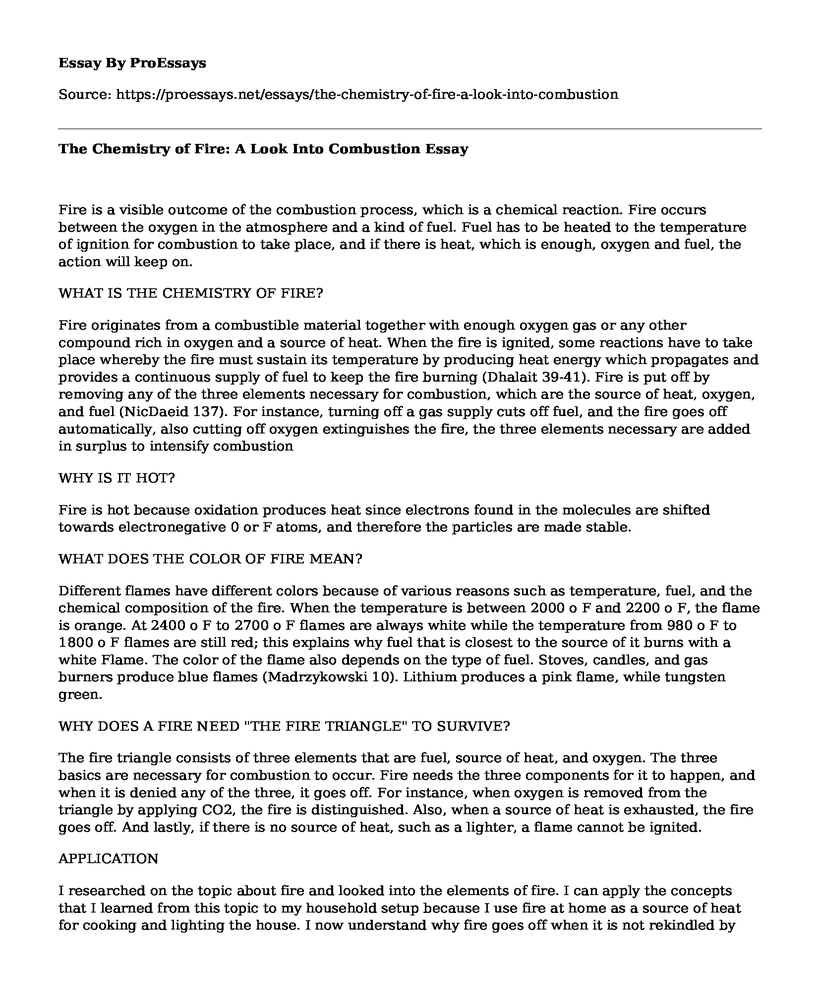Fire is a visible outcome of the combustion process, which is a chemical reaction. Fire occurs between the oxygen in the atmosphere and a kind of fuel. Fuel has to be heated to the temperature of ignition for combustion to take place, and if there is heat, which is enough, oxygen and fuel, the action will keep on.
WHAT IS THE CHEMISTRY OF FIRE?
Fire originates from a combustible material together with enough oxygen gas or any other compound rich in oxygen and a source of heat. When the fire is ignited, some reactions have to take place whereby the fire must sustain its temperature by producing heat energy which propagates and provides a continuous supply of fuel to keep the fire burning (Dhalait 39-41). Fire is put off by removing any of the three elements necessary for combustion, which are the source of heat, oxygen, and fuel (NicDaeid 137). For instance, turning off a gas supply cuts off fuel, and the fire goes off automatically, also cutting off oxygen extinguishes the fire, the three elements necessary are added in surplus to intensify combustion
WHY IS IT HOT?
Fire is hot because oxidation produces heat since electrons found in the molecules are shifted towards electronegative 0 or F atoms, and therefore the particles are made stable.
WHAT DOES THE COLOR OF FIRE MEAN?
Different flames have different colors because of various reasons such as temperature, fuel, and the chemical composition of the fire. When the temperature is between 2000 o F and 2200 o F, the flame is orange. At 2400 o F to 2700 o F flames are always white while the temperature from 980 o F to 1800 o F flames are still red; this explains why fuel that is closest to the source of it burns with a white Flame. The color of the flame also depends on the type of fuel. Stoves, candles, and gas burners produce blue flames (Madrzykowski 10). Lithium produces a pink flame, while tungsten green.
WHY DOES A FIRE NEED "THE FIRE TRIANGLE" TO SURVIVE?
The fire triangle consists of three elements that are fuel, source of heat, and oxygen. The three basics are necessary for combustion to occur. Fire needs the three components for it to happen, and when it is denied any of the three, it goes off. For instance, when oxygen is removed from the triangle by applying CO2, the fire is distinguished. Also, when a source of heat is exhausted, the fire goes off. And lastly, if there is no source of heat, such as a lighter, a flame cannot be ignited.
APPLICATION
I researched on the topic about fire and looked into the elements of fire. I can apply the concepts that I learned from this topic to my household setup because I use fire at home as a source of heat for cooking and lighting the house. I now understand why fire goes off when it is not rekindled by adding more wood, because one of the three basics that support combustion, that is, fuel is cut off from the triangle. Also, it has become clear why fire goes off when it is covered by an object such as a blanket because oxygen supply is cut off. I have also come to understand why different flames have different colors. For instance, the yellow flame is produced when there is incomplete combustion of oxygen with fuel, while a blue flame is created when there is complete combustion of oxygen with fuel. In class, we learned the topic of thermochemistry, which deals with exothermic and endothermic reactions (Drysdale 138-150). An exothermic reaction is a type of response that liberates a lot of heat to the environment, and therefore I can connect why fire is hot because it is an exothermic reaction that occurs. When an exothermic reaction occurs, it leads to high temperatures, and that's why we have different color flames of fire.
Works Cited
Dhalait, Iqbal Abdul. "Chemistry of Fire." (2019). http://nopr.niscair.res.in/bitstream/123456789/51211/1/SR%2056%2811%29%2039-41.pdf
Drysdale, D. D. "Thermochemistry." SFPE handbook of fire protection engineering. Springer, New York, NY, 2016. 138-150. https://link.springer.com/chapter/10.1007/978-1-4939-2565-0_5
Madrzykowski, Daniel. "Fire Dynamics: The Science of Fire Fighting." International Fire Service Journal of Leadership & Management 10 (2016). https://web.a.ebscohost.com/abstract?direct=true&profile=ehost&scope=site&authtype=crawler&jrnl=15543439&AN=119098127&h=1zAKdmoJNaQryLT4RFx576Ngz74KZDZ2m2cObkrY0eUYRDZXQx%2f0ZeMRgdwlciQojyGp76H%2fmLektdCC8dN9fQ%3d%3d&crl=c&resultNs=AdminWebAuth&resultLocal=ErrCrlNotAuth&crlhashurl=login.aspx%3fdirect%3dtrue%26profile%3dehost%26scope%3dsite%26authtype%3dcrawler%26jrnl%3d15543439%26AN%3d119098127
NicDaeid, N. "Chemistry of Fire." Forensic Engineering (2017): 137. https://books.google.co.ke/books?hl=en&lr=&id=EIPDDgAAQBAJ&oi=fnd&pg=PA137&dq=What+is+the+chemistry+of+fire%3F&ots=clS_X4nx9-&sig=Wol4-RVvmJoJtEVAR8EF_6hKUqQ&redir_esc=y#v=onepage&q=What%20is%20the%20chemistry%20of%20fire%3F&f=false
Cite this page
The Chemistry of Fire: A Look Into Combustion. (2023, Aug 16). Retrieved from https://proessays.net/essays/the-chemistry-of-fire-a-look-into-combustion
If you are the original author of this essay and no longer wish to have it published on the ProEssays website, please click below to request its removal:
- Willie and Billie in Death of the Salesman: The Problem of Trust and Psychological Breakdown
- Essay Sample on Ancient Global City: Tell El-'Ajjul
- King Lear by William Shakespeare Essay Example
- Essay Example on Japan's Blunder: Attack on Peral Harbor & Atomic Missiles
- Essay Example on Frankenstein: Who Is the Real Monster?
- Essay Example on Decolonization and Cold War: The New Phase of Imperialism
- Essay Example on DuPont Model: Essential Financial Analysis Framework







